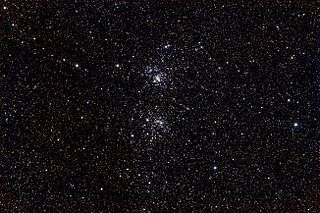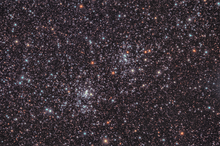Double Cluster
The Double Cluster (also known as Caldwell 14) consists of the open clusters NGC 869 and NGC 884 (often designated h Persei and χ Persei, respectively), which are close together in the constellation Perseus. Both visible with the naked eye, NGC 869 and NGC 884 lie at a distance of 7,500 light years.[1]
| Double Cluster | |
|---|---|
 | |
| Observation data (J2000.0 epoch) | |
| Constellation | Perseus |
| Right ascension | 2h 20m |
| Declination | 57° 08′ |
| Distance | 7,500 ly (2,300 Pc) |
| Apparent magnitude (V) | 3.7 and 3.8 |
| Apparent dimensions (V) | 60′ |
| Physical characteristics | |
| Other designations | Caldwell 14 |
Membership
NGC 869 has a mass of 3,700 solar masses and NGC 884 weighs in at 2,800 solar masses; however, later research has shown both clusters are surrounded with a very extensive halo of stars, with a total mass for the complex of at least 20,000 solar masses.[2] Based on their individual stars, the clusters are relatively young, both 12.8 million years old.[3] In comparison, the Pleiades have an estimated age ranging from 75 million years to 150 million years.
There are more than 300 blue-white super-giant stars in each of the clusters. The clusters are also blueshifted, with NGC 869 approaching Earth at a speed of 39 km/s (24 mi/s) and NGC 884 approaching at a similar speed of 38 km/s (24 mi/s).[4] Their hottest main sequence stars are of spectral type B0. NGC 884 includes five prominent red supergiant stars, all variable and all around 8th magnitude: RS Persei, AD Persei, FZ Persei, V403 Persei, and V439 Persei.
History

Greek astronomer Hipparchus cataloged the object (a patch of light in Perseus) as early as 130 BCE. However, the true nature of the Double Cluster was not discovered until the invention of the telescope, many centuries later. In the early 19th century William Herschel was the first to recognize the object as two separate clusters. The Double Cluster is not included in Messier's catalog, but is included in the Caldwell catalogue of popular deep-sky objects.[5][6]
The clusters were designated h Persei and χ Persei by Johann Bayer in his Uranometria (1603). It is sometimes claimed that Bayer could not have resolved the pair into two patches of nebulosity, and that χ refers to the Double Cluster and h to a nearby star.[7] Bayer's Uranometria chart for Perseus does not show them as nebulous objects, but his chart for Cassiopeia does, and they are described as Nebulosa Duplex in Schiller's Coelum Stellatum Christianum, which was assembled with Bayer's help.[8]
Location
The Double Cluster is circumpolar (continuously above the horizon) from most northern temperate latitudes. It is in proximity to the constellation Cassiopeia. The Double Cluster is approximately the radiant of the Perseid meteor shower, which peaks annually around August 12 or 13. Although easy to locate in the northern sky, observing the Double Cluster in its two parts requires optical aid. They are described as being an "awe-inspiring" and "breathtaking" sight, and are often cited as a target in astronomy observer's guides.[9]

Mythology
Perseus is the mythological symbol of adventure. Perseus was born the son of the Greek god Zeus. Along with beheading Medusa, Perseus performed other heroic deeds as well, such as saving Andromeda who was a princess chained to a rock as a sacrifice to a sea monster. Due to his great accomplishments, the gods placed Perseus among the stars, with the head of Medusa in one hand and the jewelled sword in the other. The Double Cluster represents the jewelled handle of Perseus's sword.
Footnotes
References
- Keller, Stefan C.; Grebel, Eva K.; Miller, Grant J.; Yoss, Kenneth M. (2001). "UBVI and Hα photometry of the h and χ Persei cluster". The Astronomical Journal. 122: 248. arXiv:astro-ph/0104179. Bibcode:2001AJ....122..248K. doi:10.1086/321139.
- Currie, Thayne; Hernandez, Jesus; Irwin, Jonathan; Kenyon, Scott J.; Tokarz, Susan; Balog, Zoltan; Bragg, Ann; Berlind, Perry; Calkins, Mike (2010). "The Stellar Population of h and χ Persei: Cluster properties, membership, and the intrinsic colors and temperatures of stars". The Astrophysical Journal Supplement. 186 (2): 191. arXiv:0911.5514. Bibcode:2010ApJS..186..191C. doi:10.1088/0067-0049/186/2/191.
- Slesnick, Catherine L.; Hillenbrand, Lynne A.; Massey, Philip (2002). "The star formation history and mass function of the Double Cluster h and χ Persei". The Astrophysical Journal. 576 (2): 880. arXiv:astro-ph/0205130. Bibcode:2002ApJ...576..880S. doi:10.1086/341865.
- Kharchenko, N.V.; Piskunov, A.E.; Röser, S.; Schilbach, E.; Scholz, R.-D. (2005). "Astrophysical parameters of Galactic open clusters". Astronomy and Astrophysics. 438 (3): 1163. arXiv:astro-ph/0501674. Bibcode:2005A&A...438.1163K. doi:10.1051/0004-6361:20042523.
- O'Meara, Stephen James (2002). The Caldwell Objects. Cambridge University Press. ISBN 978-0-521-82796-6.
- "Introduction". Caldwell Club. astroleague.org. Retrieved 8 September 2006.
- O'Meara, Stephen James; Green, Daniel W.E. (February 2003). "The mystery of the Double Cluster". Sky and Telescope. Vol. 105 no. 2. pp. 116–119.
- Wagman, Morton (2003). Lost Stars. McDonald & Woodward. p. 240. ISBN 0939923785.
- Chaple, Glenn (January 2011). "A double take". Astronomy. 39 (1).
External links
| Wikimedia Commons has media related to Double Cluster. |
- "Double Cluster". SEDS.
- "Double Cluster". AstroPhoto.net.
- "Perseus Double Cluster". Dark Atmospheres Photography.
- "The Double Cluster". Astronomy Picture of the Day. NASA. 4 December 2009.
- Double Cluster on WikiSky: DSS2, SDSS, GALEX, IRAS, Hydrogen α, X-Ray, Astrophoto, Sky Map, Articles and images